weird but cute sea animals
Disclaimer: This post may contain affiliate links. All hosted affiliate links follow our editorial policies.
With only approximately 20% of their total area explored, the world's oceans contain some of the most uniquely weird animals on the planet.
Many people have compared the deep ocean to deep space. Both are extremely difficult to get to, due to the lack of visibility and expensive nature of the technology required for scientific study.
As a result, there are more and more scientific discoveries with each new deep sea expedition. The excursions often produce insane photos and videos.
But even if you happen to have thalassophobia (or fear of the ocean ), as I do, there are some sea creatures that are undeniably fascinating.
If you love learning about uniquely bizarre creatures, read on for our guide to 40 cool and weird ocean animals, from the cutest to the ugliest and everything in between.
READ MORE: 70 Cool & Weird Animals Around the World
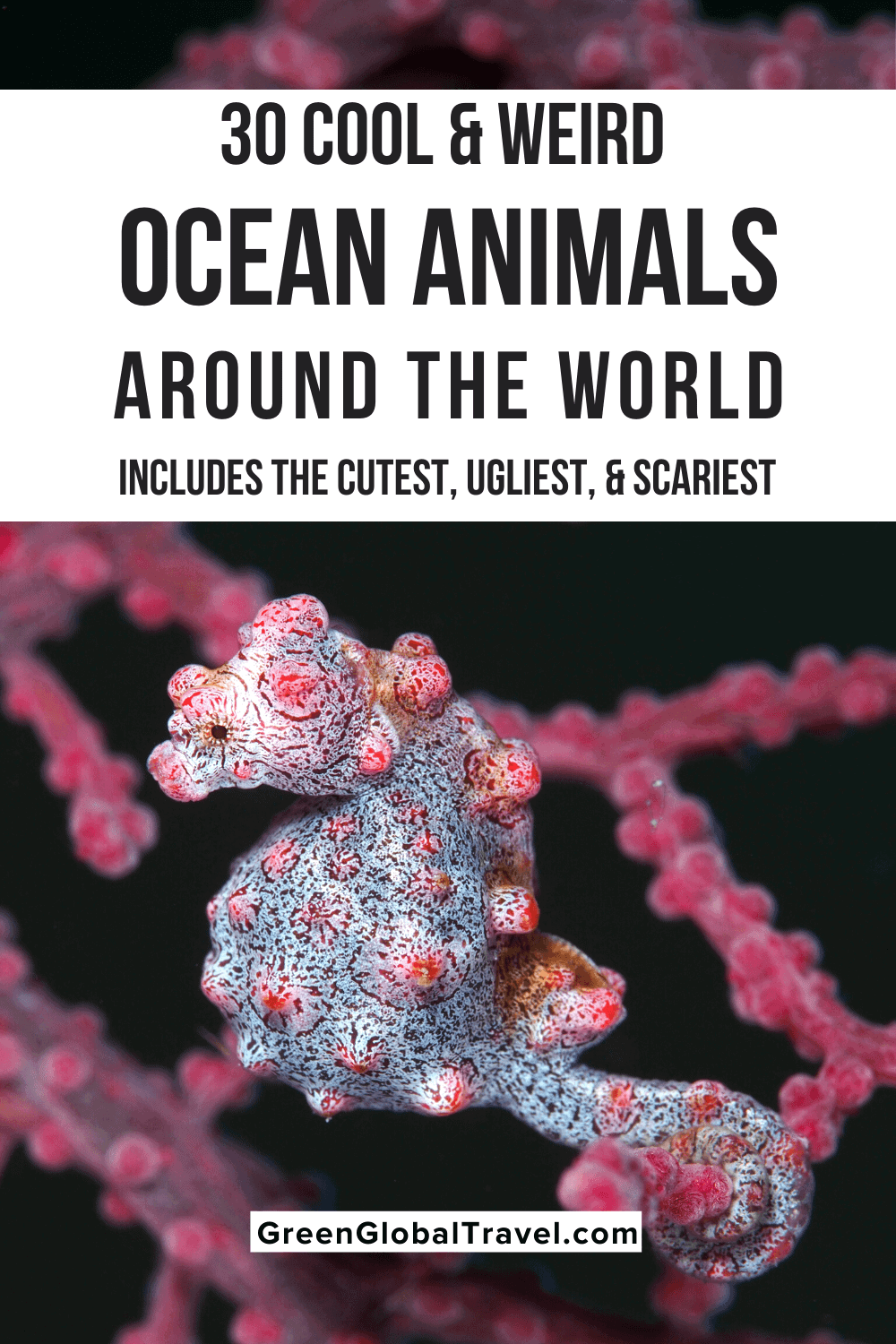
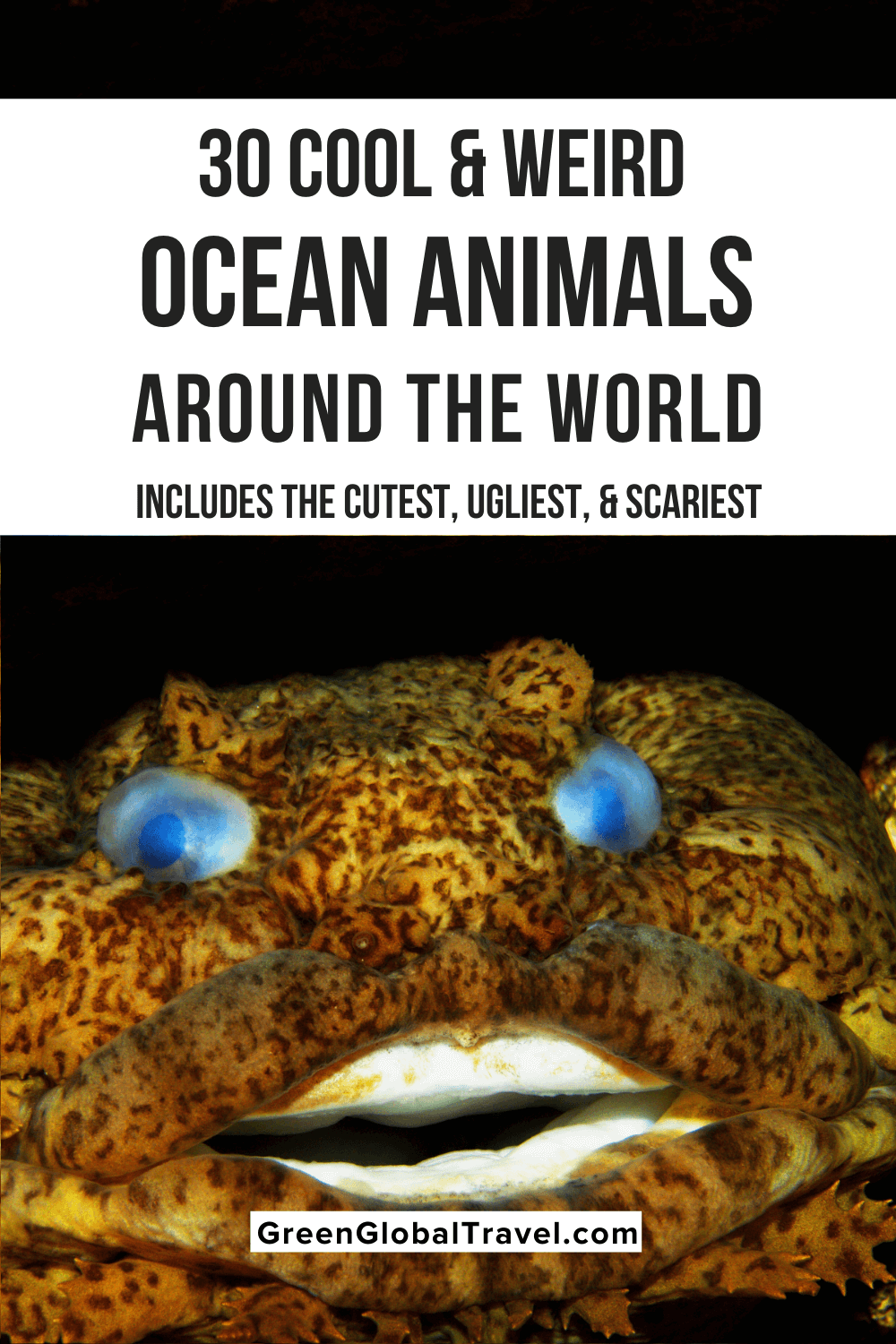
Weird Ocean Animals Guide
- Cutest Sea Creatures
- Ugly Sea Creatures
- Weirdest Ocean Animals
- Scariest Sea Creatures
- Rarest/Smallest/Largest Sea Creatures
Cutest Sea Creatures
1. Irrawaddy Dolphin
Latin Name:Orcaella brevirostris
Habitat:Shallow, near-shore tropical and subtropical marine waters
Size:Length: 4.8 to 9 feet; Weight: 420 pounds
Diet:Cephalopods, fish, crustaceans
Conservation Status:Endangered, population decreasing
With their formidable foreheads, rounded faces, and broad flippers, this adorable Southeast Asian species look like some anime artist's cartoonish rendering of a dolphin.
Interestingly, their genetic make-up is more closely related to the orca, a.k.a. Killer Whale . They're primarily found in the Irrawaddy River of Myanmar.
Unlike any other dolphin, the Irrawaddy Dolphin's u-shaped blowhole is placed on the left of the midline and opens towards the front.
Their short beaks are also very different from those of other dolphins , with 12-19 peg-like teeth on each side of their jaws.
READ MORE: Saving Asian Animals: The 10 Best Wildlife Conservation Programs
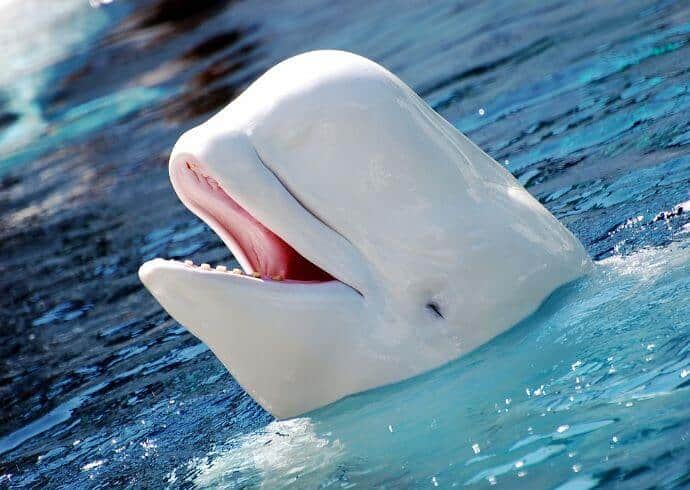
2. Beluga Whale
Latin Name: Delphinapterus leucas
Habitat: Arctic and sub-Arctic waters
Size: Length: 14 ft (adult); Weight: 3,000 lbs. (adult)
Diet: Fish, squid, crustaceans
Conservation Status: Least Concern, with some sub-populations Endangered
The Beluga Whale is a popular sea creature known for its unique appearance. They are typically pale white all over and have distinctly shaped heads.
As social animals, they usually travel in pods. Belugas are the only member of their genus, Delphinapterus, and their closest relative is the Narwhal.
They are not quite as common as Bottlenose Dolphins, and can only be found in the Arctic regions. Here, they must fend off Polar Bears and Killer Whales, their primary predators.
These creatures are also increasingly threatened by climate change, hunting , and oil production, all of which are big problems for the Arctic region on the whole.
READ MORE: Arctic Animals: 30 Species of Arctic Birds, Mammals & Whales
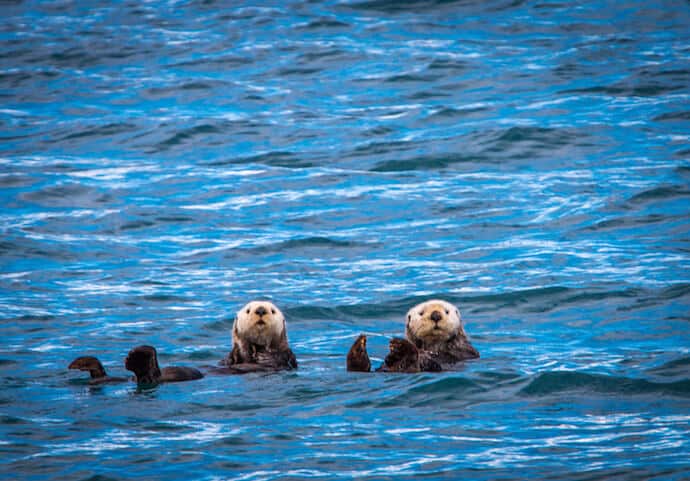
3. Sea Otter
Latin Name: Enhydra lutris
Habitat: Northern and eastern North Pacific Ocean
Size: Length: 3.3-4.9 ft ; Weight: 31-99 lbs.
Diet: Sea urchins, clams, mussels, and crabs
Conservation Status: Endangered
These omnivores are the largest member of the weasel family, but the smallest marine mammal in all of North America.
Their furry hides are part of what makes them so cute. The other part is how they swim on their backs and balance snacks on their stomach.
Sea Otters eat up to 25% of their body weight every day. They can dive down to 250 ft, and hold their breath for over 5 minutes to find the crustaceans that they eat.
Unfortunately, these otterly adorable furballs are listed as an endangered species. This is due to commercial fishing, oil spills, and their main predator, the Great White Shark .
Sea Otters are considered a keystone species (meaning they have a great impact on their ecosystem), so numerous conservation efforts are underway to ensure the survival their survival.
READ MORE: Alaskan Animals: 40 Species You Can See On Your Alaska Vacation
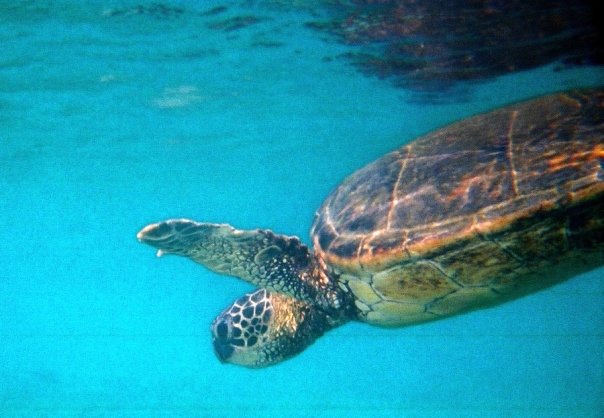
4. Green Sea Turtle
Latin Name: Chelonia mydas
Habitat: Tropical and sub-tropical waters
Size: Length: 3-4 ft.; Weight: 300-500 lbs.
Diet: Seagrass, algae, crustaceans, and worms
Conservation Status: Endangered
The Green Sea Turtle is another cool marine animal that has become an icon thanks to movies like Finding Nemo and Moana. They're also common in mythology dating backs thousands of years.
One of the most fascinating facts about these beloved sea creatures is how far they travel in between finding food and laying eggs.
Female Sea Turtles always return to the beaches on which they were born to nest. But their eggs and hatchlings arevery vulnerable to predation from birds, crabs, and almost every animal in the sea.
Environmental issues such as ecosystem degradation and commercial fishing threaten both hatchlings and adult Sea Turtles.
Thankfully, these immensely popular sea animals have lots of support in wildlife conservation circles, including great NGOs such as Sea Shepherd , Sea Turtle Conservancy, and WWF .
READ MORE: Our Sea Turtle Rescue with Sea Turtle Inc in South Padre Island, TX
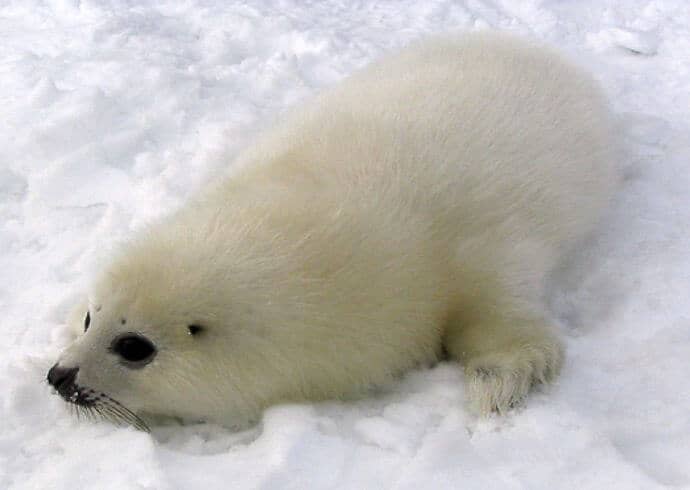
5. Harp Seal
Latin Name: Pagophilus groenlandicus
Habitat: North Atlantic and Arctic Oceans
Size: Length: 5.6 ft ; Weight: 290 lbs.
Diet: Fish and crustaceans
Conservation Status: Least Concern (Population Increasing)
There's no denying the fact that baby Harp Seals are one of the world's cutest marine animals. They're fuzzy and white as babies, with adorably wide puppy dog eyes.
Their fuzzy white fur helps young Harp Seals absorb sunlight and stay warm. When they're around 3 to 4 weeks old, they start to shed the fur.
Although they lose some of their adorableness when they get older and the white fur is replaced with grey skin, harp seals are still fascinating creatures.
They can travel long distances and dive up to 1,300 ft for at least 16 minutes. The name harp seal comes from the black patch on their backs which resemble harps.
READ MORE: S wimming with Galapagos Sea Lions (With Video)

6. Emperor Penguin
Latin Name: Aptenodytes forseteri
Habitat: Antarctica
Size: Length: 3.6-4.3 ft. (30 in. wingspan) ; Weight: 51 lbs.
Diet: Fish, squid, and krill
Conservation Status: Near Threatened
Endemic to Antarctica , the Emperor Penguin is known for having some of the world's cutest and cuddliest-looking little chicks.
As made famous by the filmMarch of the Penguins, their fuzzy grey/white bodies and black-and-white heads make them look extremely soft and cozy.
As adults, they lose the fuzz and develop brilliant yellow and orange markings around their neck and head. The distinct tuxedo-like contrast on their heads and bodies makes them look quite fancy!
When they're full-grown, Emperor Penguins are the tallest and heaviest of all penguin species. They can also dive deeper than any other bird.
READ MORE: Penguins of Antarctica Photo Gallery
Ugly Sea Creatures
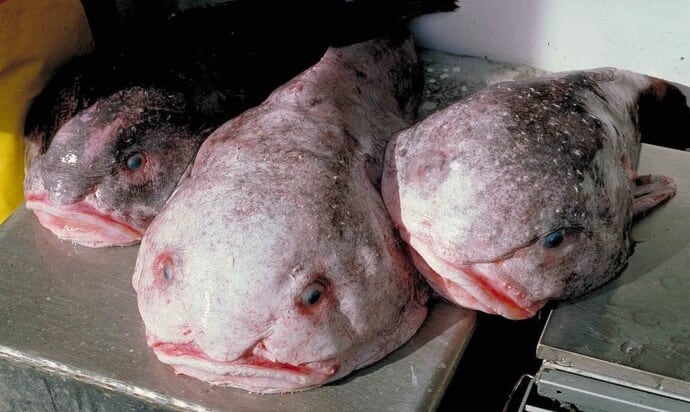
7. Blobfish
Latin Name: Psychrolutes marcidus
Habitat: Deep waters of Australia, Tasmania, and New Zealand
Size: Length: 12 in ; Weight: 20 lbs
Diet: Any organic matter that floats near them
Conservation Status: Not Extinct
With its appearance akin to a glob of melting fat or sack of skin, the Blobfish is truly a repulsive creature with a seemingly frowning facial expression.
Voted the planet's most hideous species in a poll conducted by the Ugly Animal Preservation Society, these comically unattractive animals were only discovered in 2003. Today, there are an estimated total of 420 Blobfish remaining in the world's oceans.
These deep sea creatures are as interesting as they are ugly, with few bones and no swim bladders. This is a big factor in their rather unfortunate appearance.
Living at extreme depths of 2,000 to 9,000+ ft, where the pressure is 120 times greater than it is at the surface, they look like normal fish.
It is only when they are brought up to shallow waters (or on land) and exposed to air that the aptly-named Blobfish looks truly repulsive.
READ MORE: Animals in Kenya: A Guide to 40 Species (Including the Ugly Five)
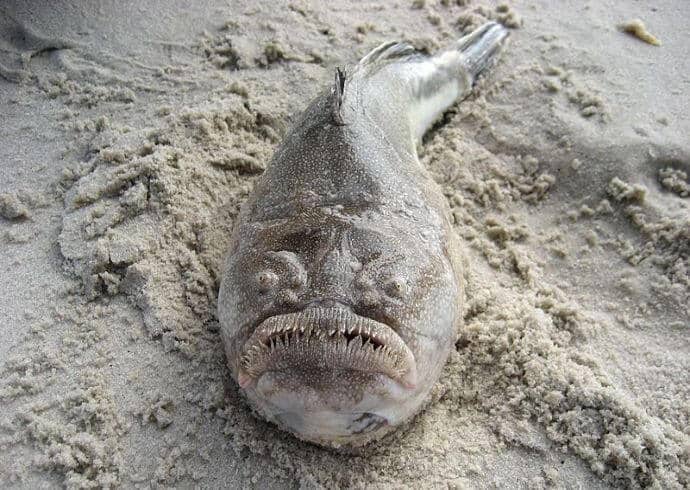
8. Northern Stargazer
Latin Name: Astroscopus guttatus
Habitat: Worldwide shallow and deep saltwaters
Size: Length: 8-18 in. ; Weight: 20 lbs.
Diet: Small fish, crab, and other crustaceans
Conservation Status: Not Extinct
Rivaling the Blobfish for the title of World's Ugliest Fish, the Northern Stargazer appears to be as menacing as the Blobfish is pitiful.
The mouth and eyes of the Northern Stargazer fish are on top of its head, facing upward.
To catch its prey, it uses its fins to burrow under and blend into the sand on the ocean floor, leaving only its hideous face visible (but well-camouflaged).
One other interesting fact about these amazing animals of the sea is that they can deliver a powerful electric charge that stuns prey and helps to wards off other predators.
READ MORE: Amazing Animal Facts: A-to-Z
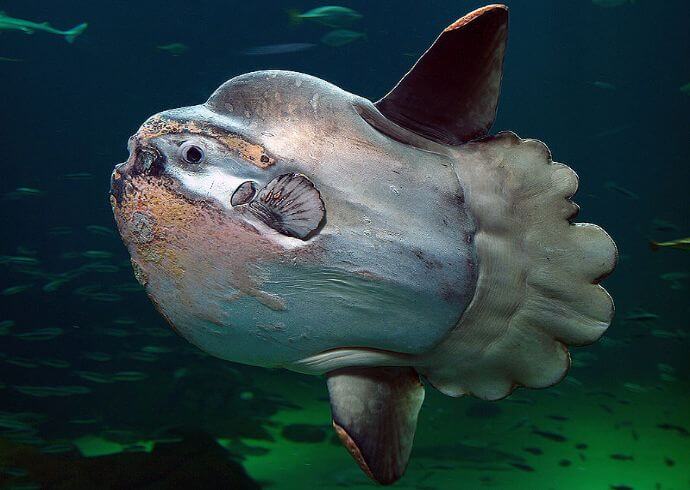
9. Ocean Sunfish
Latin Name: Mola mola
Habitat: Tropical and temperate waters
Size: Length: 5.9 ft ; Weight: 2,200 lbs.
Diet: Jellyfish, small fish, zooplankton, and algae
Conservation Status: Vulnerable due to bycatch
The dopey-looking Ocean Sunfish don't seem quite as ugly compared to the last two ocean creatures we showed you. But their unusual anatomy certain merits a mention on this list.
Ocean Sunfish are the heaviest bony fish in the world, with adults weighing over 2,000 pounds. They're a very flat fish, with one large fin on the top and bottom.
In comparison, their small side fins and scalloped "tail" (which is more like the edge of a plate) seem comically disproportionate.
Ocean Sunfish naturally have trouble swimming well due to these anatomical anomalies. And really,the bizzare fish just seems like a mistake of evolution.
READ MORE: 30 Amazing Galapagos Islands Animals
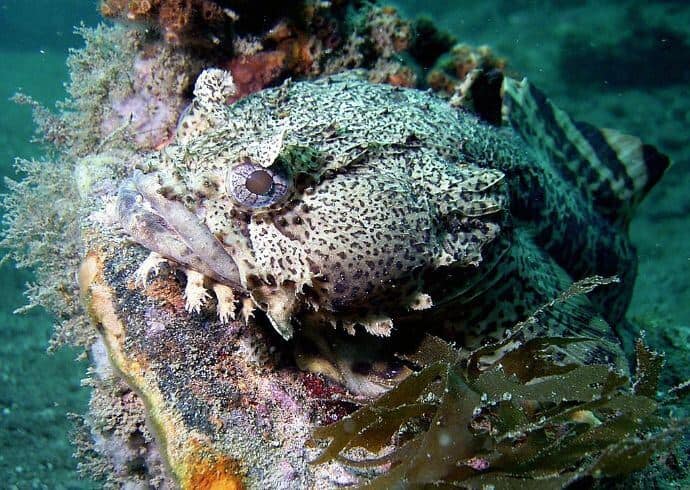
10. Oyster Toadfish
Latin Name: Opsanus tau
Habitat: Near the shore from Maine to Florida
Size: Length: 15-17 in. ; Weight: about 5 lbs.
Diet: Small fish and crustaceans
Conservation Status: Least Concern
As its name would suggest, the Oyster Toadfish has the slimy skin of an oyster , which is covered in warts like a toad.
The name is also due to its remarkably strong jaws, which can crush the thick shells of oysters as if they were nothing.
Male Oyster Toadfish make a loud, foghorn-like noise to attract females. Personally, it's hard to imagine how either their looks or their sound would make them appealing to the opposite sex!
Interestingly, the system that controls their balance is similar to that of us humans. So NASA has actually sent some Oyster Toadfish into space in order to conduct scientific experiments.
READ MORE: 5 Endangered Species that Mate for Life
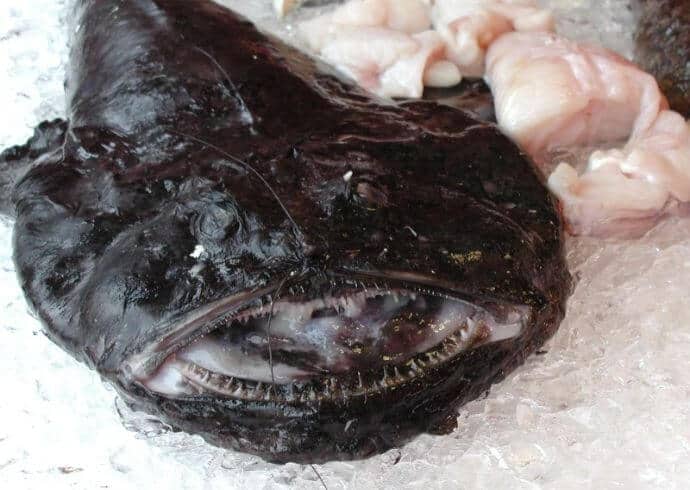
11. Monkfish
Latin Name: Lophius
Habitat: Atlantic and Indian Oceans
Size: Length: 3-4.5 ft ; Weight: 27-70 lbs.
Diet: Fish (even other monkfish), crustaceans, and seabirds
Conservation Status: Not Extinct
Like the Blobfish and Stargazer, the Monkfish is a bottom-dwelling, ugly sea creature.
It has small, protruding eyes, mottled skin, and fearsome rows of fang-like teeth.
Other common names for the Monkfish are "sea devils," "frog fish," and "poor man's lobster," due to the meat's texture being similar to that of lobster.
Initially known as a delicacy in Japan , Monkfish is becoming increasingly popular in high-end restaurants. So while it may look unappetizing, its flavor is famously delicious!
READ MORE: Invasive Species List: 10 Destructive Species You Can Eat
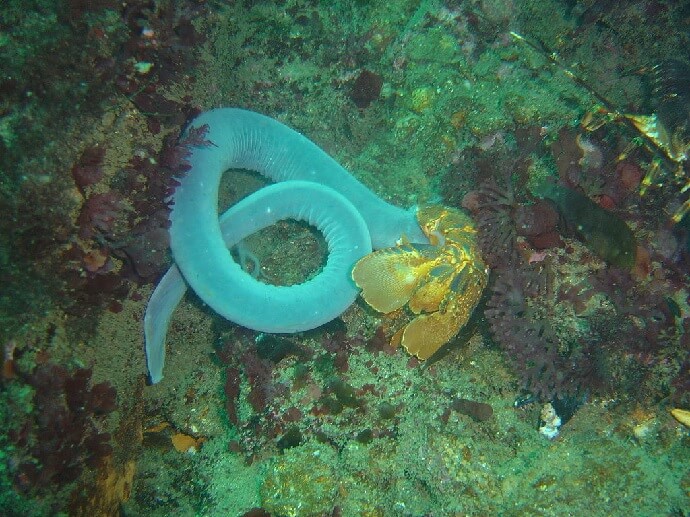
12. Hagfish
Latin Name: Myxini
Habitat: Deep, cold waters
Size: Length: 20 in.; Weight: 1-3 lbs.
Diet: Worms and crustaceans
Conservation Status: Data Deficient
There are 76 different species of Hagfish, which are small, eel-like creatures that live in burrows on the sea floor.
So why did they make our list of the ugliest sea creatures? For starters, the Hagfish has a weird, leech-like mouth on the front of its face.
Then there's the fact that the Hagfish has an extremely unusual way of eating: They bury themselves within their prey and then proceed to devour it from the inside!
Lastly, they can also produce liters of slime to deter predators.
READ MORE: 30 Antarctic Animals You Can See on an Antarctica Cruise
Weirdest Ocean Animals
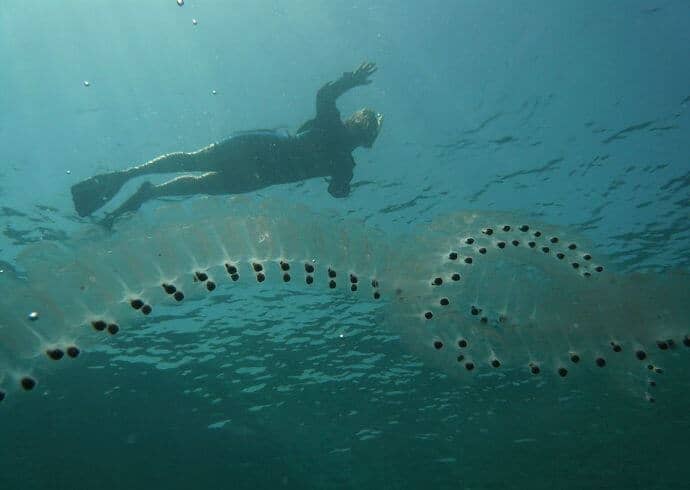
13. Sea Salp
Latin Name: Salpa thompsoni
Habitat: Deep Antarctic waters
Size: Length: 10cm ; Weight: Not much
Diet: Phytoplankton
Conservation Status: Least Concern
These gelatinous, translucent fish are weird ocean animals that move through the ocean by pumping water through their bodies.
While they move, the Sea Salps filter phytoplanktons– microscopic marine algae that are the base of the ocean's food chain– from the water.
When they're young, Sea Salps swim alone. But when they're older, they form tight linear or circular chains with many others of their kind.
These linear chains of tiny salps can travel thousands of feet every night!
READ MORE: Amazing Animal Facts 2: Animal Olympians
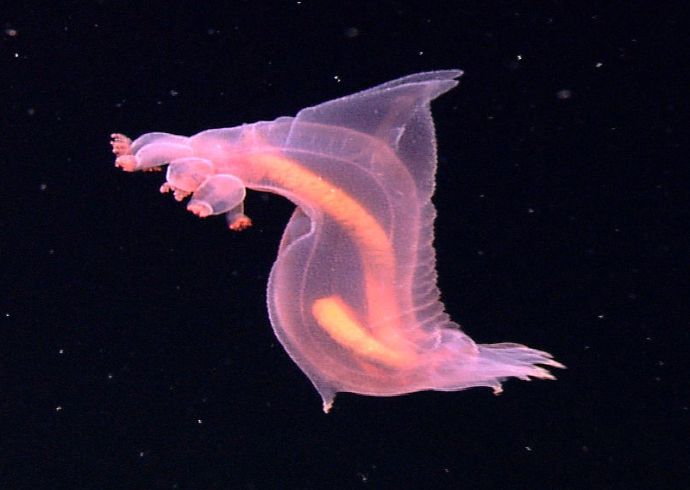
14. Pink Sea Through Fantasia
Latin Name: Enypniastes eximia
Habitat: Celebes Sea in the Western Pacific
Size: Length: 4.3-9.8 in.; Weight: 5-10 lbs
Diet: Sediment
Conservation Status: Data Deficient
The Pink Sea Through Fantasia is another translucent ocean animal that lives in extremely deep depths (around 8,200 feet) near the Philippines .
A relative of the Sea Cucumber, the Pink Fantasia was discovered in 2007. But scientists still know very little about these weird aquatic animals.
The oddest aspect of the Pink Sea Through Fantasia is that you actually can see its intenstines through the translucent flesh.
The bioluminescent creature (meaning it emits light) uses this ability to ward of predators.
READ MORE: The Top 15 Things To Do In Coron, Palawan
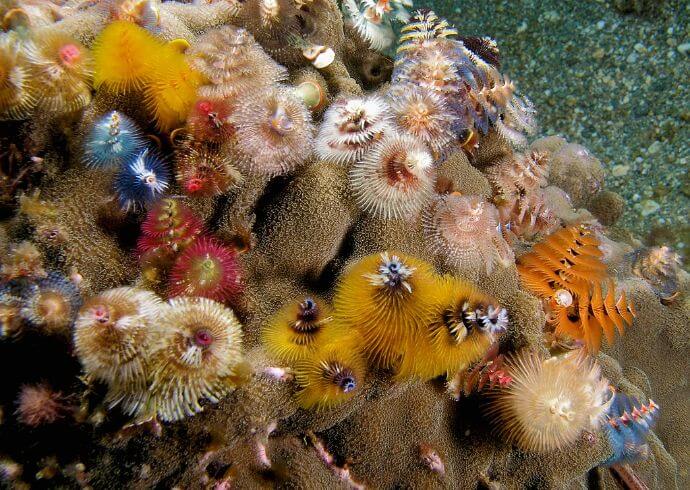
15. Christmas Tree Worm
Latin Name: Spirobranchus giganteus
Habitat: Tropical coral reefs
Size: Length: 1.5 in.
Diet: Plankton
Conservation Status: Stable
The Christmas Tree Worm is named for its spiral plumes, which resemble the shape of Christmas Trees . Their vivid colors can vary between red, orange, yellow, blue, and white.
This is one of those weird sea animals that's bizarre, but in a fun, interesting way.
The spiral plumes are the worm's breathing and feeding apparatus, while the body is embedded in the coral reef. If the worm is threatened, the plumes can be retracted quickly.
Although the Christmas Tree Worm is not a threatened species, the coral reefs where they make their homes are increasingly endangered.
Much marine conservation work is aimed at protecting coral reefs due to their importance to countless forms of aquatic life.
READ MORE: Indian Animals: A Guide to 40 Incredible Indian Wildlife Species
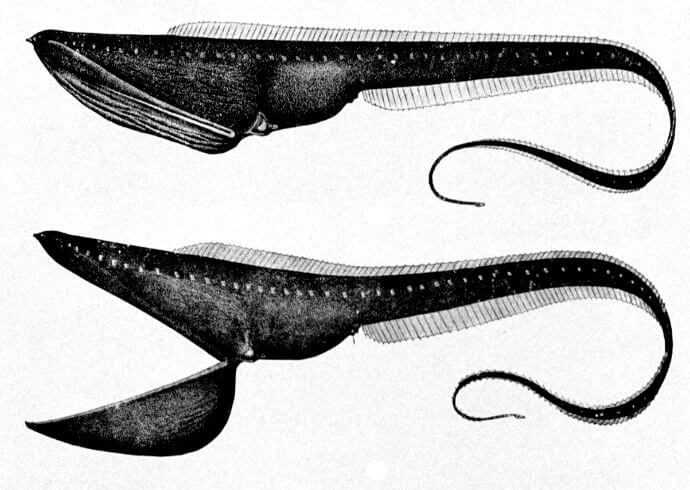
16. Gulper Eel
Latin Name: Eurypharynx pelecanoides
Habitat: Tropical and temperate oceans; 500-6,000 ft
Size: Length: 2-6 ft.; Weight: 20 lbs.
Diet: Fish and crustaceans
Conservation Status: Not Extinct
Also known as the Pelican Eel, the Gulper Eel has an oddly shaped mouth that can unhinge and scoop up prey like a Pelican does.
They typically don't use the full extent of their mouth unless their normal food is running low. But when they do, they can consume prey even larger than themselves!
The end of the Gulper Eel's tail has a bioluminescent photophore that can emit a pink/red light, which is used to attract prey.
This is one of the weirdest looking sea animals because of how big its head is compared to its tail. It doesn't really look like any other eels or fish you've ever seen.
READ MORE: Madagascar Animals Photo Gallery

17. Coffinfish
Latin Name: Chaunax endeavouri
Habitat: Salty temperate waters of the southwestern Pacific
Size: Length: max of 8.7 in.
Diet: Crustaceans and small fish
Conservation Status: Not Extinct
The Coffinfish (which is also known as the Sea Toad), is a deep water relative of the Frogfish. They sometimes bounce around the ocean floor on their bottom fins.
These unusual fish live at ocean depths of 650 to 8,000 ft. Their anatomy has adjusted to these high-pressure environments, so when taken out of the water they sorta resemble the Blobfish.
Coffinfish also have a small lure protruding out from behind their eyes, which they use to attract and ambush unsuspecting prey.
They can also inflate themselves by up to 30% and hold their breath like this for about 5 minutes. This is used mainly when they need to conserve energy and find food.
READ MORE: S wimming with Sharks in Bora Bora, Tahiti
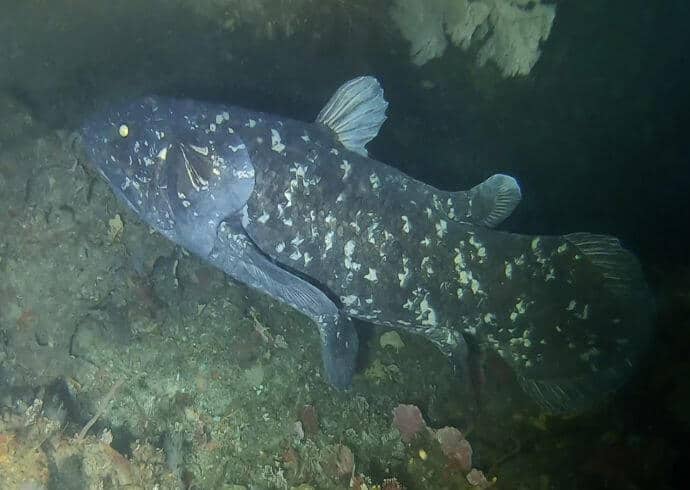
18. Coelacanth
Latin Name: Latimeria
Habitat: Coasts of Africa and Indonesia
Size: Length: 6.5 ft.; Weight: 198 lbs.
Diet: Fish and squid
Conservation Status: Not Extinct
Scientists discovered the Coelacanth in 1938, which was quite shocking considering the fact that it had long been thought to be extinct.
They live in ocean depths of up to 2,300 feet, which might explain why these weird underwater animals weren't discovered for decades.
Their fins are attached to short limbs, making them very unusual fish. The two species of Coelacanths are the only vertebrates to have jointed skulls, which allows them to unhinge their mouths to eat.
The Coelacanths also have thick scales that are common only to other extinct fish species. This creature is truly an oddity, basically a surviving relic of the Mesozoic Era (the time of the dinosaurs).
READ MORE: 20 Endangered African Animals You Can See On A Safari
Scariest Sea Creatures
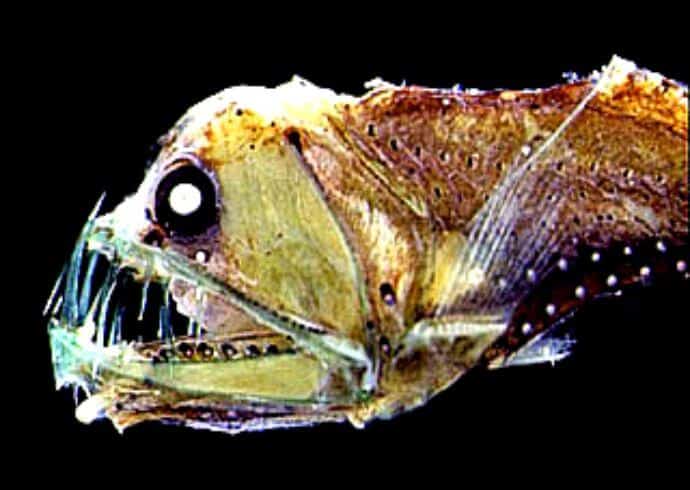
19. Sloane's Viperfish
Latin Name: Chauliodus sloani
Habitat: Deep, tropical and temperate waters
Size: bioluminescent Length: 2.5-10 in.
Diet: Small fish
Conservation Status: Not Extinct
Looking like an alien creature out of a horror film, the Sloane's Viperfish lives in the ocean's abyss at depths of 3,000 to 6,000 ft.
These frightening fish hold a Guinness world record for having the natural world's largest teeth in comparison to their head.
Their razor-sharp teeth look menacing, but their method of catching food is even scarier: They swim at very high speeds and impale their prey on their teeth.
The Sloane's Viperfish has multiple photophores for bioluminescence. One is on its dorsal fin and others along its sides, presumably used to attract prey and provide camouflage from predators.
READ MORE: 15 Harmful Traditions & Cultural Practices Tourists Shouldn't Support
20. Giant Squid
Latin Name: Architeuthis dux
Habitat: Deep ocean
Size: Length: 33-59 ft.; Weight: 1,100 lbs.
Diet: Fish, shrimp, and other squid (even small whales)
Conservation Status: Least Concern
As seen on the Discovery Channel's Monster Squid, the Giant Squid is like something straight out of your worst nightmares.
With its extremely long tentacles and a massive body that can grow up to 60 feet long, it would be a terrifying creature to encounter in the ocean.
Luckily, unless you're on a deep-sea expedition below 900 ft, it's unlikely you'll ever encounter one. But unfortunately, their depth preference prevents science from knowing much about them.
One thing we do know is that they, along with the Colossal Squid (which we'll talk about in our next section), have the largest eyes in the animal kingdom at 10cm in diameter. This allows them to see in the deep, dark depths they call home.
READ MORE: 50 Fascinating Facts About the Dhole (a.k.a. Indian Wild Dog)

21. Goblin Shark
Latin Name: Mitsukurina owstoni
Habitat: Open ocean
Size: Length: up to 12 ft; Weight: up to 460 lbs.
Diet: Fish, squid, and crustaceans
Conservation Status: Least Concern
This is where my personal fear of the ocean really starts to kick in. Just looking at this phenomenally frightening sea creature, the Goblin Shark, truly makes me cringe.
These scary sharks roam the open ocean, from the surface to over 4,000 feet deep, which (unfortunately for my research) has produced countless videos and photos of them in action.
The Goblin Shark is terrifying due to its odd anatomy, including a long snout that's disconnected from its mouth. The jaws can protrude to the same length as the snout, and often snap out to attack prey.
Like the Coelacanth, this ocean animal is considered to be a living fossil due to its rarity and relation to an extinct species from over 100 million years ago!
READ MORE: Swimming with Whale Sharks in Cancun (with Video)
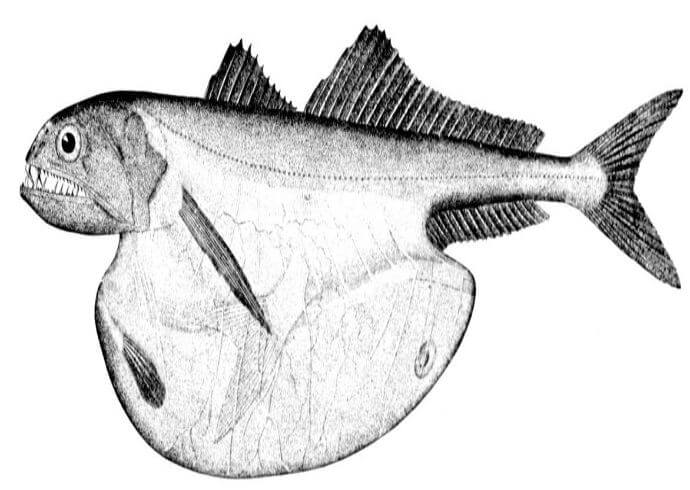
22. Black Swallower
Latin Name: Chiasmodon niger
Habitat: Deep tropical and sub-tropical waters
Size: Length: 10 in.
Diet: Bony fish
Conservation Status: Least Concern
The Black Swallower may sound like an awesome name for a pirate ship, but it's actually a fairly small fish.
But, as proof that size doesn't matter when it comes to scary species, what makes this fish frightening is its ability to swallow prey up to 10 times larger than itself.
The Black Swallower basically looks like any other fish until you notice the extended gut attached to its belly. This is useful for catching scarce prey at depths of up to 9,000 feet.
The fish often swallows its prey whole. Sometimes it even captures something too large for its body to fully consume before the prey decomposes, which can actually kill it!
READ MORE: 40 Fascinating Facts about the Markhor (National Animal of Pakistan)
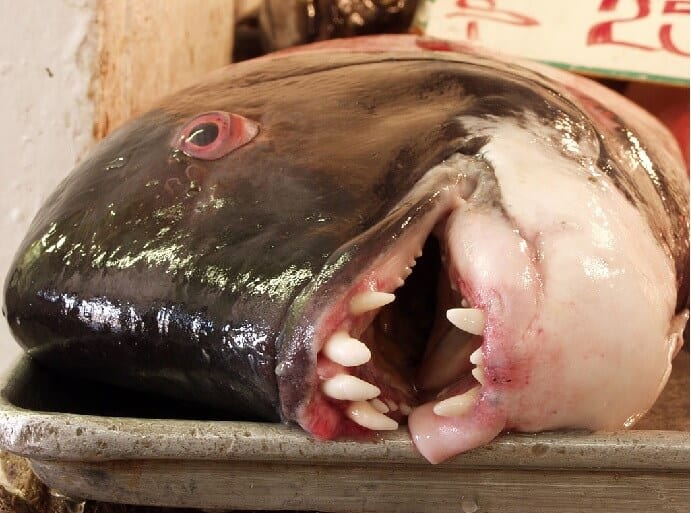
23. Sheepshead
Latin Name: Archosargus probatocephalus
Habitat: Coast of North America
Size: Length: 10-30 in.; Weight: 3-15 lbs.
Diet: Small fish, crustaceans, and plant matter
Conservation Status: Least Concern
Prepare yourself for the surprisingly creepy Sheepshead. It may look like a normal fish at first glance, but if you open its mouth you'll find bizarre, almost human-like teeth.
I don't know why, but for me this makes the Sheepshead (which looks a little like Sloth from The Goonies) seem even scarier than the Goblin Shark.
Apparently, they use these jacked-up teeth to crush the shells of their prey.
Strangely, the bizarre-looking fish is another popular, but decidedly weird delicacy .
READ MORE: Animal Selfies: The Problem with Putting Ego Over Responsibility
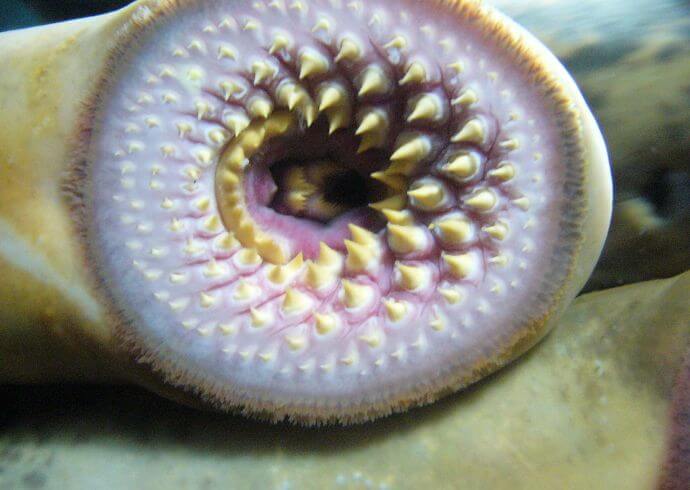
24. Lamprey
Latin Name: Petromyzontiformes
Habitat: Open ocean and sometimes freshwater
Size: Length: 5-40 in.; Weight: 2.9 oz.
Diet: Fish
Conservation Status: Not Extinct
Perhaps even more unsettling than creepy sea creatures are creepy sea parasites.
Often seen catching a free ride on the bottom or sides of larger host fish, Lampreys are small, eel-like creatures that feed like parasites.
They are terrifying because of both their mouths, which are full of rings of teeth, and the way they eat. Lampreys attach themselves to prey with their barbed tongues and gradually drain its blood.
What's even more terrifying? They've occasionally been known to attach to human swimmers! They wouldn't kill you, but it certainly sounds incredibly uncomfortable.
READ MORE: 40 Amazing Costa Rica Animals
Rarest/Smallest/Largest Sea Creatures

25. Vaquita (Rarest)
Latin Name: Phocoena sinus
Habitat: Northern Gulf of California
Size: Length: 5 ft.; Weight: 95 lbs.
Diet: Squid, crabs, and bottom-dwelling fish
Conservation Status: Critically Endangered
With a name that means "little cow" in Spanish, this adorable relative of the Dolphin will pull at your heart strings.
The Vaquita is the rarest sea mammal in the world, and there are only approximately 30 of them left in the entire world.
They are a critically endangered species due to being caught in fishing nets and poisoned by pesticides that end up in the ocean.
These incredibly rare animals can only be found in the Gulf of California, and were not discovered until 1958due to their shyness.
You can distinguish a Vaquita from a Porpoise or Dolphin by their lack of a snout, as well as the black markings around their eyes and lips.
READ MORE: Vaquita (a.k.a. Desert Porpoise) Endngered Species Spotlight
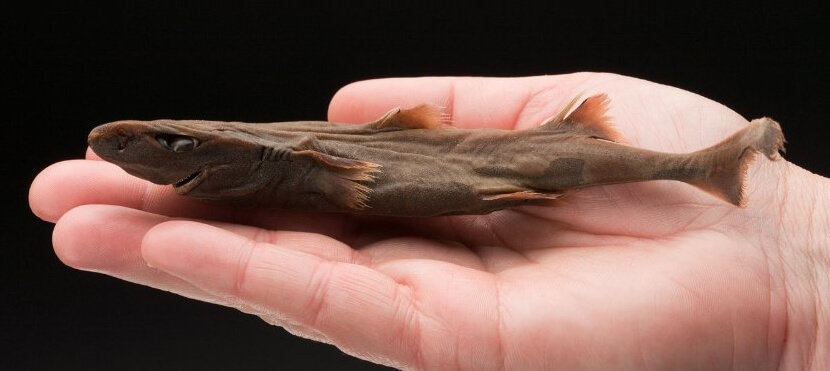
26. Dwarf Lantern Shark (Smallest)
Latin Name: Etmopterus perryi
Habitat: Coast of Columbia and Venezuela
Size: Length: 6 in.; Weight: 0.5 oz
Diet: Krill
Conservation Status: Data Deficient
If we move past various viruses, bacteria, and algae, the smallest sea creature in the world is the Dwarf Lantern Shark.
This shark gets its name from both its diminutive size and the bioluminescent properties it possesses.
The largest Dwarf Lantern Shark ever caught was only 7.8 inches long, meaning that they can easily fit in a human hand.
Probably the cutest and least dangerous shark in existence, this is the only shark species I'd personally be happy to see in the sea!
READ MORE: 5 Rare Sharks Worth Saving

27. Pygmy Seahorse
Latin Name: Hippocampus bargibanti
Habitat: Corals and sea fans in the Indo-West Pacific
Size: Length: 0.55-1.06 in.
Diet: Tiny crustaceans and zooplankton
Conservation Status: Data Deficient
Another tiny but popular sea creature is the Pygmy Seahorse, a tiny little seahorse from the hippocampus family.
It lives in the Indo-West Pacific on coral reefs and sea fans. They are each perfectly camouflaged to the reef systems in which they make their homes.
Their tiny little digestive systems mean that they're constantly grazing for food, much like you might see a land-based horse do.
In my opinion, this one could easily be placed in the "cutest sea animals" category as well!
READ MORE: 30 Facts About The Mongolian Horse (a.k.a Przewalski's Horse or Takhi)
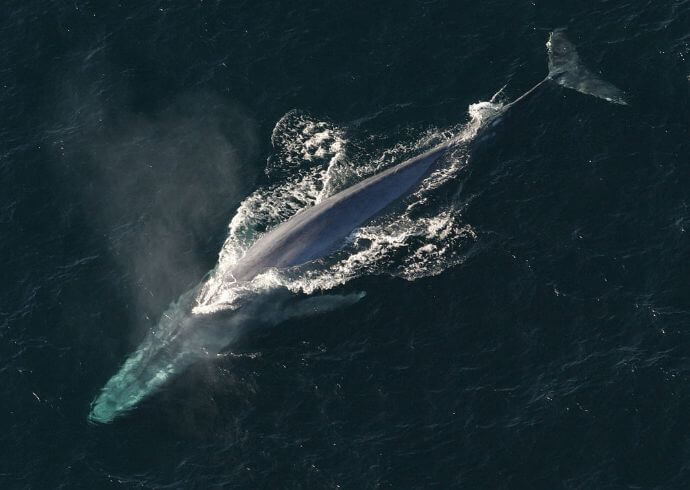
28. The Blue Whale (Largest)
Latin Name: Balaenoptera musculus
Habitat: All oceans except the Arctic
Size: Length: 79-82 ft.; Weight: 110,000-330,000 lbs. (WOW!)
Diet: Krill and other small fish
Conservation Status: Endangered
The Blue Whale is the largest animal ever recorded, both on land and in the sea. Many compare its size to that of a Boeing 747.
These whales can be seen roaming the oceans alone or in packs, and it's not difficult to find majestic photos and videos of them breaching the water's surface.
Blue Whales are record-breaking animals: Their tongues weigh as much as an Elephant , their hearts are the size of a car, and their calls are the loudest of any creature on the planet.
Unfortunately, their notoriety led to them being hunted almost to extinction in the 1800s. Though still endangered, today there are international hunting bans and conservation efforts to save the species.
READ MORE: 40 Fascinating Blue Whale Facts (From Size & Diet to Conservation)
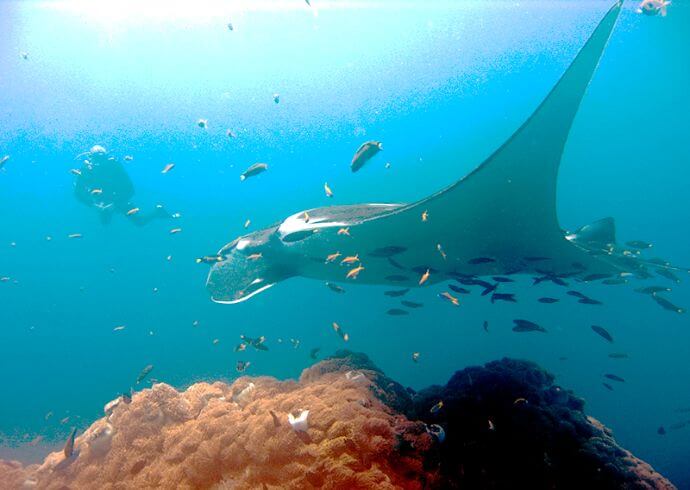
29. Giant Manta Rays
Latin Name: Mobula birostris
Habitat: Tropical, sub-tropical, and temperate waters
Size: Length: 29-foot wingspan; Weight: 3,600 lbs.
Diet: Plankton, shrimp, and small fish
Conservation Status: Vulnerable (Population Decreasing)
A personal favorite of mine, the Giant Manta Ray is the world's fifth largest marine creature.
Growing up to 3,600 pounds, with a 29-foot wingspan, these incredible sea animals can live up to 40 years old.
They have the biggest brains of any fish in the sea, and can even recognize themselves in the mirror!
These magnificent gentle giants are truly one of the most amazing ocean animals.
READ MORE: Hawaiian Monk Seal Endangered Species Spotlight
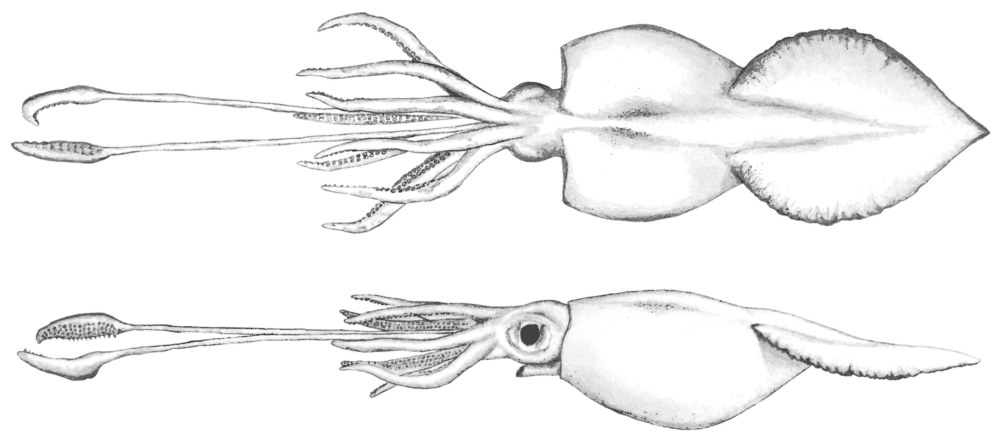
30. Colossal Squid
Latin Name: Mesonychoteuthis hamiltoni
Habitat: Antarctic waters
Size: Length: 39-46 ft.; Weight: 1100 lbs.
Diet: Small and large fish
Conservation Status: Least Concern
The Giant Squid may be scarier, but the Colossal Squid is much more interesting. It's the largest invertebrate on earth, and it also has the largest eyes of any animal.
Their sole predators, Sperm Whales, must fight off the Colossal Squid's many suctioned tentacles, each of which is equipped with sharp hooks.
Scientists have had a hard time catching and studying the species, so most of their evidence for study came from what was found in the stomachs of Sperm Whales.
As with many of the sea creatures mentioned in this article, there is still much to learn about the Colossal Squid.
And with 80% of the world's oceans yet to be explored, who knows how many other cute, ugly, strange, scary, and rare marine animals are still waiting to be discovered? –by Sonny Grace Bray; lead image & Pin of Pygmy Seahorse via Canva, Oystertoad Pin via Canva
Source: https://greenglobaltravel.com/cool-weird-ocean-animals-around-the-world/